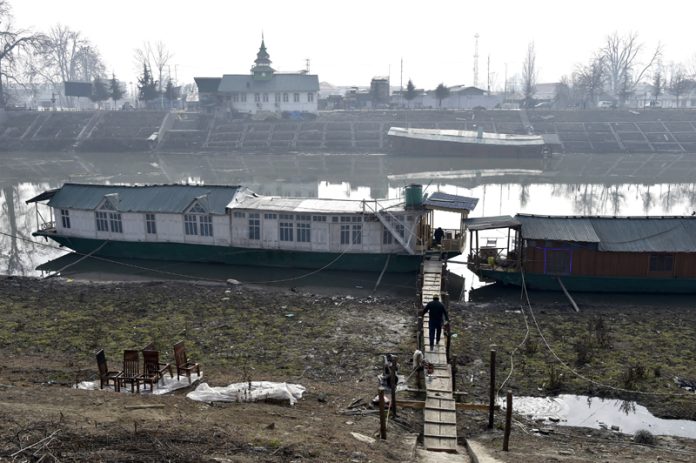Suhail Bhat
SRINAGAR, Jan 17: Kashmir is grappling with a severe water crisis as a prolonged dry winter spell has taken a toll on its water sources, raising alarm among officials about the region’s water supply.
As the water level of Kashmir’s main river, the Jhelum, plummets to an unprecedented low, registering a mere 0.75 feet at the Sangam gauge, the landscape of the river appears starkly desolate. Some parts of the riverbed are now dry and cracked, a sight never seen before. This raises concerns about the future availability of water in the region.
Sanjeev Malhotra, Chief Engineer of the Jal Shakti Department, expressed concern over the dwindling water levels. “The water supply is insufficient at the water sources, and we are unable to provide drinking water to our full capacity,” he said.
He highlighted the impact on schemes relying on the Jhelum, explaining, “We are digging small trenches around to ensure that water is available for the pumps to lift and later for distribution.”
Major water bodies supplying water to a vast population, including Sukhnag, Kal Nag, and Dachigam, have experienced reduced discharge.
Malhotra described the situation as unprecedented and unavoidable, emphasizing the need for rain to recharge these critical water sources. “We are managing the situation so far and dispatching water tankers to areas where the need is felt,” Malhotra said. He sounded the alarm that the situation could worsen if the dry weather persists.
The Valley has experienced a prolonged dry spell with minimal snowfall this winter, reflecting a 79% deficit in December 2023 and a 100% deficit in January 2024.
Mukhtar Ahmad, Director of the Meteorological Department, attributed the unusual weather patterns to the El Niño phenomenon, resulting in a dry Himalayan region. “The prolonged presence of El Niño, persisting for the last two months, is a major contributing factor to the ongoing dry spell,” he said. He explained that the absence of western disturbances is a primary cause, with no significant relief expected soon.
Highlighting global atmospheric pressure shifts, he said, “Such dry spells are witnessed in intervals of two to three years or even five years.”
The MeT director said while a feeble Western disturbance is expected from the 15th to the 16th, offering slight relief, the weather is predicted to remain dry until the 20th of the month.
Ahmad suggested a potential change after the 25th, with various weather models indicating the possibility of rain or snow. “We will provide more accurate information in the coming days,” he said.


